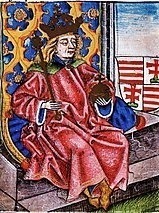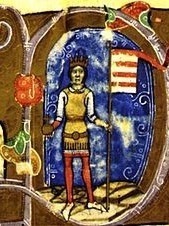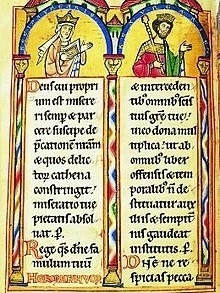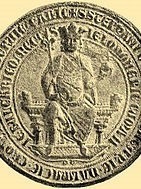Family tree Snelder - Versteegh » King Bela IV of Hungary (1206-1270)
Personal data King Bela IV of Hungary
Source 1- He was born November 1206 in Esztergom, Komarom-Esztergom, Hungary.
 Attention: Age at marriage (??-??-1218) below 16 years (12).
Attention: Age at marriage (??-??-1218) below 16 years (12). - He died on May 3, 1270 in Esztergom, Komarom-Esztergom, Hungary, he was 63 years old.
- A child of Andreas II of Hungary and Gertrude of Merania of Hungary
Household of King Bela IV of Hungary
He is married to Maria Laskarina of Byzantium.
They got married in the year 1218, he was 11 years old.
Child(ren):
Notes about King Bela IV of Hungary
https://en.wikipedia.org/wiki/B%C3%A9la_IV_of_Hungary
Béla IV (1206 – 3 May 1270) was King of Hungary and Croatia between 1235 and 1270, and Duke of Styria from 1254 to 1258. Being the oldest son of King Andrew II, he was crowned upon the initiative of a group of influential noblemen in his father's lifetime in 1214. His father, who strongly opposed Béla's coronation, refused to give him a province to rule until 1220. In this year, Béla was appointed Duke of Slavonia, also with jurisdiction in Croatia and Dalmatia. Around the same time, Béla married Maria, a daughter of Theodore I Laskaris, Emperor of Nicaea. From 1226, he governed Transylvania with the title Duke. He supported Christian missions among the pagan Cumanswho dwelled in the plains to the east of his province. Some Cuman chieftains acknowledged his suzerainty and he adopted the title of King of Cumania in 1233. King Andrew died on 21 September 1235 and Béla succeeded him. He attempted to restore royal authority, which had diminished under his father. For this purpose, he revised his predecessors' land grants and reclaimed former royal estates, causing discontent among the noblemen and the prelates.
The Mongols invaded Hungary and annihilated Béla's army in the Battle of Mohi on 11 April 1241. He escaped from the battlefield, but a Mongol detachment chased him from town to town as far as Trogir on the coast of the Adriatic Sea. Although he survived the invasion, the Mongols devastated the country before their unexpected withdrawal in March 1242. Béla introduced radical reforms in order to prepare his kingdom for a second Mongol invasion. He allowed the barons and the prelates to erect stone fortresses and to set up their private armed forces. He promoted the development of fortified towns. During his reign, thousands of colonists arrived from the Holy Roman Empire, Poland and other neighboring regions to settle in the depopulated lands. Béla's efforts to rebuild his devastated country won him the epithet of "second founder of the state" (Hungarian: második honalapító).
He set up a defensive alliance against the Mongols, which included Daniil Romanovich, Prince of Halych, Boleslaw the Chaste, Duke of Cracow and other Ruthenian and Polish princes. His allies supported him in occupying the Duchy of Styria in 1254, but it was lost to King Ottokar II of Bohemia six years later. During Béla's reign, a wide buffer zone—which included Bosnia, Barancs (Braničevo, Serbia) and other newly conquered regions—was established along the southern frontier of Hungary in the 1250s.
Béla's relationship with his oldest son and heir, Stephen, became tense in the early 1260s, because the elderly king favored his daughter Anna and his youngest child, Béla, Duke of Slavonia. He was forced to cede the territories of the Kingdom of Hungary east of the river Danube to Stephen, which caused a civil war lasting until 1266. Nevertheless, Béla's family was famed for his piety: he died as a Franciscan tertiary, and the veneration of his three saintly daughters—Kunigunda, ;Yolanda, and Margaret—was confirmed by the Holy See.
Timeline King Bela IV of Hungary
 grandparents
grandparents
 parents
parents
 brothers/sisters
brothers/sisters
 children
children
Ancestors (and descendant) of Bela IV of Hungary
Bela IV of Hungary  | ||||||||||||||||||||||||||||||||||
1218 | ||||||||||||||||||||||||||||||||||
Maria Laskarina of Byzantium | ||||||||||||||||||||||||||||||||||
Relationship King Bela IV of Hungary
- Bela IV of Hungary is the 53th great grandson of Titus Manlius Imperiosus Torquatus:Titus Manlius Imperiosus TorquatusTitus Manlius TorquatusTitus Manlius TorquatusAulus Manlius TorquatusTitus Manlius TorquatusDecimus Junius Silanus ManlianusMarcus Junius Silanus consulMarcus Junius SilanusMarcus Junius Silanus consulMarcus Junius SilanusJunia Calvina EquitusGaius SallustiusGaius Ummidius Quadratus SallustiusGaius Ummidius Quadratus Annianus VerusGaius Ummidius Quadratus Annianus Verus FulviusUmmidia Commificia AntoniaPendania Pedanius FuscusMariana MinorAurelia PompeianaClaudiaConstantius I Chlorus of RomeUnkownProcopius UsurperProcopiusProcopius II Magister Militum of ByzantiumProcopius Anthemius I of the of the Western Roman EmpireAlypia Princess of the of RomeCaratene Agrippina of NarbonneClothilde of BurgundyChlothar I of the FranksCharibert I of ParisBilichildeArnoald of MetzDodaAnsegisel of the FranksPepin II of HerstalCharles Martel of the FranksBernard of HeristalThiedradaHedwig of BavariaConrad I of BurgundyConrad II of AuxerreAdelgunde of BurgundyEberhard I of BonngauErenfried II of BonngauHerman of LorraineEzzo of LorraineRicheza of LotharingiaAdelaide of PolandGéza I of of HungaryKing Almos Konstantin of HungaryBéla II of HungaryGeza II of HungaryBela III of HungaryAndreas II of HungaryBela IV of Hungary
Sources
- WikiTree, via https://www.myheritage.nl/research/colle...
Béla of Hungary (geboren Arpadhazi)Geslacht: ManGeboorte: nov 1206 - Esztergom, Komarom-Esztergom, HungaryHuwelijk: 1218Overlijden: 3 mei 1270 - Esztergom, Komarom-Esztergom, HungaryVader: King András II Hungary (geboren Arpadhazi)Moeder: Gertrude of Hungary (geboren Méranie)Echtgenote: Maria Hungary (geboren Lascaris)Kinderen: István V of Hungary (geboren Arpadhazi)St. Margit of Hungary (geboren Arpadhazi)Szabina of Hungary (geboren Arpadhazi)Kunignuda of Hungary (geboren Arpadhazi)Katalin of Hungary (geboren Arpadhazi)Konstancia of Hungary (geboren Arpadhazi)Erzsebet of Hungary (geboren Arpadhazi)Jolan Magyar (geboren Arpadhazi)Béla of Hungary (geboren Arpadhazi)Anna of Slavonia (geboren Arpadhazi)Broers/zusters: Anna Maria of Hungary (geboren Arpadhazi)Kálmán ArpadhaziSzent Erzsébet of Hungary (geboren Arpadhazi)Andras of Hungary (geboren Arpadhazi)Foto's:
www.wikitree.com
Matches in other publications
This person also appears in the publication:Historical events
Day of death May 3, 1270
- Graaf Floris V (Hollands Huis) was from 1256 till 1296 sovereign of the Netherlands (also known as Graafschap Holland)
Same birth/death day
- 1152 » Matilda of Boulogne (b. 1105)
- 1270 » Béla IV of Hungary (b. 1206)
- 1294 » John I, Duke of Brabant (b. 1252)
- 1330 » Alexios II Megas Komnenos, Emperor of Trebizond (b. 1282)
- 1410 » Antipope Alexander V
- 1481 » Mehmed the Conqueror, Ottoman sultan (b. 1432)
About the surname Of Hungary
- View the information that Genealogie Online has about the surname Of Hungary.
- Check the information Open Archives has about Of Hungary.
- Check the Wie (onder)zoekt wie? register to see who is (re)searching Of Hungary.
Roel Snelder, "Family tree Snelder - Versteegh", database, Genealogy Online (https://www.genealogieonline.nl/stamboom-snelder-versteegh/I507046.php : accessed May 24, 2024), "King Bela IV of Hungary (1206-1270)".




